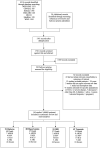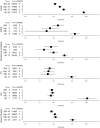Quantifying the Excess Risk of Adverse COVID-19 Outcomes in Unvaccinated Individuals With Diabetes Mellitus, Hypertension, Ischaemic Heart Disease or Myocardial Injury: A Meta-Analysis
- PMID: 35557537
- PMCID: PMC9090337
- DOI: 10.3389/fcvm.2022.871151
Quantifying the Excess Risk of Adverse COVID-19 Outcomes in Unvaccinated Individuals With Diabetes Mellitus, Hypertension, Ischaemic Heart Disease or Myocardial Injury: A Meta-Analysis
Abstract
Background: More than 80% of individuals in low and middle-income countries (LMICs) are unvaccinated against coronavirus disease 2019 (COVID-19). In contrast, the greatest burden of cardiovascular disease is seen in LMIC populations. Hypertension (HTN), diabetes mellitus (DM), ischaemic heart disease (IHD) and myocardial injury have been variably associated with adverse COVID-19 outcomes. A systematic comparison of their impact on specific COVID-19 outcomes is lacking. We quantified the impact of DM, HTN, IHD and myocardial injury on six adverse COVID-19 outcomes: death, acute respiratory distress syndrome (ARDS), invasive mechanical ventilation (IMV), admission to intensive care (ITUadm), acute kidney injury (AKI) and severe COVID-19 disease (SCov), in an unvaccinated population.
Methodology: We included studies published between 1st December 2019 and 16th July 2020 with extractable data on patients ≥18 years of age with suspected or confirmed SARS-CoV-2 infection. Odds ratios (OR) for the association between DM, HTN, IHD and myocardial injury with each of six COVID-19 outcomes were measured.
Results: We included 110 studies comprising 48,809 COVID-19 patients. Myocardial injury had the strongest association for all six adverse COVID-19 outcomes [death: OR 8.85 95% CI (8.08-9.68), ARDS: 5.70 (4.48-7.24), IMV: 3.42 (2.92-4.01), ITUadm: 4.85 (3.94-6.05), AKI: 10.49 (6.55-16.78), SCov: 5.10 (4.26-6.05)]. HTN and DM were also significantly associated with death, ARDS, ITUadm, AKI and SCov. There was substantial heterogeneity in the results, partly explained by differences in age, gender, geographical region and recruitment period.
Conclusion: COVID-19 patients with myocardial injury are at substantially greater risk of death, severe disease and other adverse outcomes. Weaker, yet significant associations are present in patients with HTN, DM and IHD. Quantifying these associations is important for risk stratification, resource allocation and urgency in vaccinating these populations.
Systematic review registration: https://www.crd.york.ac.uk/prospero/, registration no: CRD42020201435 and CRD42020201443.
Keywords: COVID-19; adverse outcomes; cardiovascular risk factors; diabetes; hypertension; ischaemic heart disease; myocardial injury.
Copyright © 2022 Ng, Pan, Mouyis, Kondapally Seshasai, Kapil, Rice and Gupta.
Conflict of interest statement
The authors declare that the research was conducted in the absence of any commercial or financial relationships that could be construed as a potential conflict of interest.
Figures
Similar articles
-
COVID-19 Outcomes Amongst Patients With Pre-existing Cardiovascular Disease and Hypertension.Cureus. 2021 Feb 18;13(2):e13420. doi: 10.7759/cureus.13420. Cureus. 2021. PMID: 33763316 Free PMC article.
-
Risk factors and outcomes associated with diabetes mellitus in COVID-19 patients: a meta-analytic synthesis of observational studies.J Diabetes Metab Disord. 2022 Jul 18;21(2):1395-1405. doi: 10.1007/s40200-022-01072-6. eCollection 2022 Dec. J Diabetes Metab Disord. 2022. PMID: 35874425 Free PMC article.
-
Unravelling the complex interplay of age, comorbidities, and multimorbidities in COVID-19 disease progression: Clinical implications and future perspectives.Heliyon. 2024 Aug 2;10(15):e35570. doi: 10.1016/j.heliyon.2024.e35570. eCollection 2024 Aug 15. Heliyon. 2024. PMID: 39170247 Free PMC article.
-
Coronavirus disease (COVID-19): A systematic review and meta-analysis to evaluate the impact of various comorbidities on serious events.Diabetes Metab Syndr. 2020 Sep-Oct;14(5):1017-1025. doi: 10.1016/j.dsx.2020.06.064. Epub 2020 Jul 2. Diabetes Metab Syndr. 2020. PMID: 32634716 Free PMC article.
-
Incidence, risk factors and outcomes of acute kidney injury among COVID-19 patients: A systematic review of systematic reviews.Front Med (Lausanne). 2022 Nov 4;9:973030. doi: 10.3389/fmed.2022.973030. eCollection 2022. Front Med (Lausanne). 2022. PMID: 36405588 Free PMC article.
Cited by
-
Assessing the Vulnerability of Splenectomized Patients to Severe COVID-19 Outcomes: A Systematic Review and Meta-Analysis.Vaccines (Basel). 2025 Feb 18;13(2):203. doi: 10.3390/vaccines13020203. Vaccines (Basel). 2025. PMID: 40006749 Free PMC article. Review.
-
Myocardial Injuries in COVID-19: More Questions Than Answers.J Clin Med. 2022 Aug 3;11(15):4527. doi: 10.3390/jcm11154527. J Clin Med. 2022. PMID: 35956141 Free PMC article.
References
-
- Ritchie H, Mathieu E, Rodés-Guirao L, Appel C, Giattino C, Ortiz-Ospina E, et al. . Coronavirus Pandemic (COVID-19). Our World in Data; (2020) Mar 5. Available online at: https://ourworldindata.org/ (accessed March 27, 2022).
-
- Biccard BM, Gopalan PD, Miller M, Michell WL, Thomson D, Ademuyiwa A, et al. . Patient care and clinical outcomes for patients with COVID-19 infection admitted to African high-care or intensive care units (ACCCOS): a multicentre, prospective, observational cohort study. Lancet. (2021) 397:1885–94. 10.1016/S0140-6736(21)00441-4 - DOI - PMC - PubMed
-
- Danza P. SARS-CoV-2 Infection and Hospitalization Among Adults Aged ≥18 Years, by Vaccination Status, Before and During SARS-CoV-2 B.1.1.529 (Omicron) Variant Predominance — Los Angeles County, California, November 7, 2021–January 8, 2022. MMWR Morb Mortal Wkly Rep. (2022) 71:177–81. 10.15585/mmwr.mm7105e1 - DOI - PMC - PubMed
Publication types
LinkOut - more resources
Full Text Sources
Miscellaneous



